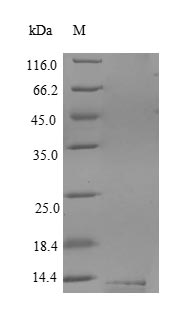The mature human CD59 protein-encoding gene (26-102aa) is tagged with a 6xHis sequence at the N-terminus to create the target gene. PCR amplification is used to replicate this target gene, which is then inserted into an expression vector for recombinant plasmid construction. The plasmids are introduced into yeast cells, which are cultured to induce protein expression. After cultivation, the culture supernatant is collected and purified via affinity chromatography, yielding recombinant human CD59 protein with a purity level exceeding 90% as confirmed by SDS-PAGE.
Human CD59 is a crucial membrane complement regulatory protein (mCRP) that plays a significant role in the immune system by protecting host cells from complement-mediated lysis. It is a GPI-anchored protein widely expressed across various human cell types, including neurons and erythrocytes [1][2]. CD59 functions primarily by inhibiting the formation of the membrane attack complex (MAC), specifically blocking the assembly of the C5b-9 complex, which is responsible for cell lysis [2][3]. This protective mechanism is vital for maintaining cellular integrity, particularly in tissues exposed to high levels of complement activation, such as the blood and nervous system [4][5].
Studies have shown that CD59 is often overexpressed in several types of tumors, including breast and lung cancers, where it correlates with poor prognosis and tumor progression [1][3][6]. The overexpression of CD59 in these malignancies is thought to confer a survival advantage by protecting cancer cells from complement-dependent cytotoxicity, thereby facilitating tumor immune evasion [3][6]. Furthermore, CD59's interaction with immune cells, such as T lymphocytes and NK cells, suggests that it may also play a role in modulating immune responses beyond complement inhibition [7][8].
References:
[1] Q. Ouyang, L. Zhang, Y. Jiang, X. Ni, S. Chen, F. Ye, et al., The membrane complement regulatory protein cd59 promotes tumor growth and predicts poor prognosis in breast cancer, International Journal of Oncology, vol. 48, no. 5, p. 2015-2024, 2016. https://doi.org/10.3892/ijo.2016.3408
[2] E. Pedersen, H. Aass, T. Rootwelt, M. Fung, J. Lambris, & T. Mollnes, Cd59 efficiently protects human nt2‐n neurons against complement‐mediated damage, Scandinavian Journal of Immunology, vol. 66, no. 2-3, p. 345-351, 2007. https://doi.org/10.1111/j.1365-3083.2007.01959.x
[3] B. Li, H. Lin, J. Fan, J. Lan, Y. Zhong, Y. Yang, et al., Cd59 is overexpressed in human lung cancer and regulates apoptosis of human lung cancer cells, International Journal of Oncology, vol. 43, no. 3, p. 850-858, 2013. https://doi.org/10.3892/ijo.2013.2007
[4] T. Miwa, L. Zhou, B. Hilliard, H. Molina, & W. Song, Crry, but not cd59 and daf, is indispensable for murine erythrocyte protection in vivo from spontaneous complement attack, Blood, vol. 99, no. 10, p. 3707-3716, 2002. https://doi.org/10.1182/blood.v99.10.3707
[5] G. Wu, W. Hu, A. Shahsafaei, W. Song, M. Dobarro, G. Sukhovaet al., Complement regulator cd59 protects against atherosclerosis by restricting the formation of complement membrane attack complex, Circulation Research, vol. 104, no. 4, p. 550-558, 2009. https://doi.org/10.1161/circresaha.108.191361
[6] R. Zhang, Q. Liu, J. Peng, M. Wang, X. Gao, Q. Liao, et al., Pancreatic cancer-educated macrophages protect cancer cells from complement-dependent cytotoxicity by up-regulation of cd59, Cell Death and Disease, vol. 10, no. 11, 2019. https://doi.org/10.1038/s41419-019-2065-4
[7] Y. Huang, C. Smith, H. Song, B. Morgan, R. Abagyan, & S. Tomlinson, Insights into the human cd59 complement binding interface toward engineering new therapeutics, Journal of Biological Chemistry, vol. 280, no. 40, p. 34073-34079, 2005. https://doi.org/10.1074/jbc.m504922200
[8] J. Chen, P. Ding, L. Li, H. Gu, X. Zhang, L. Zhang, et al., Cd59 regulation by sox2 is required for epithelial cancer stem cells to evade complement surveillance, Stem Cell Reports, vol. 8, no. 1, p. 140-151, 2017. https://doi.org/10.1016/j.stemcr.2016.11.008






